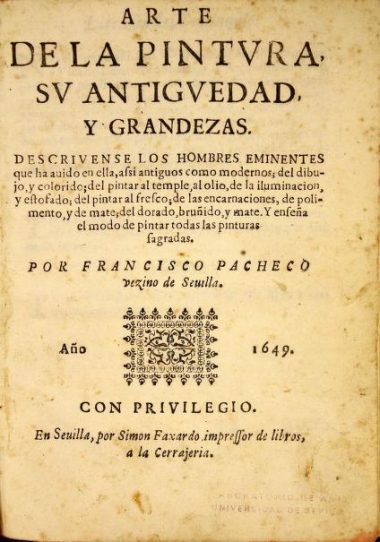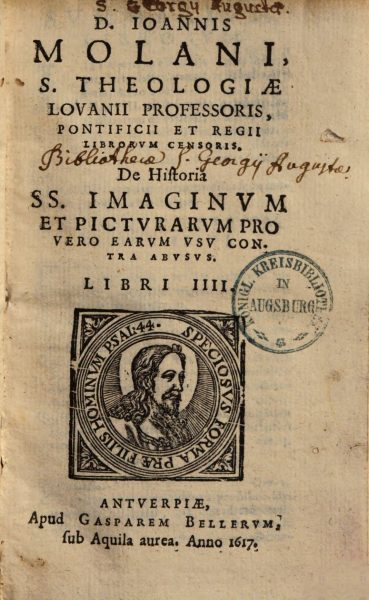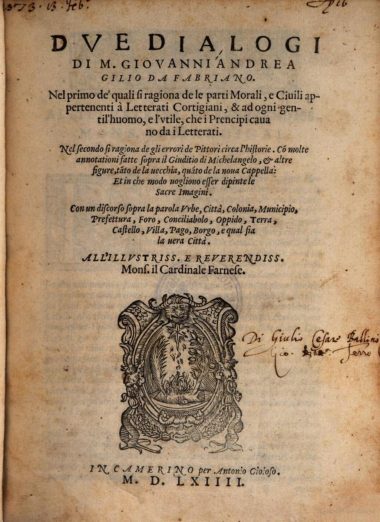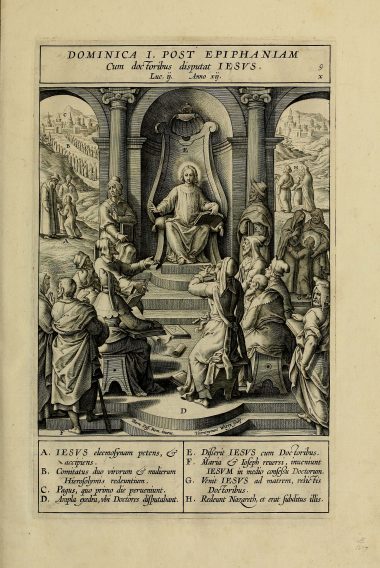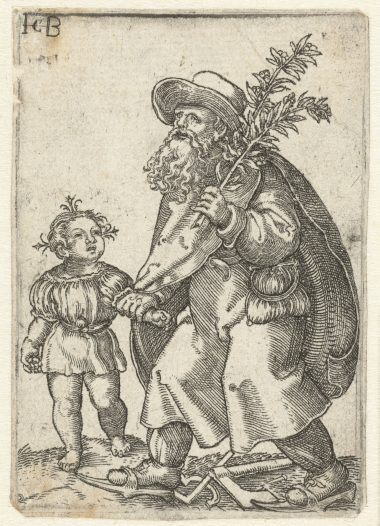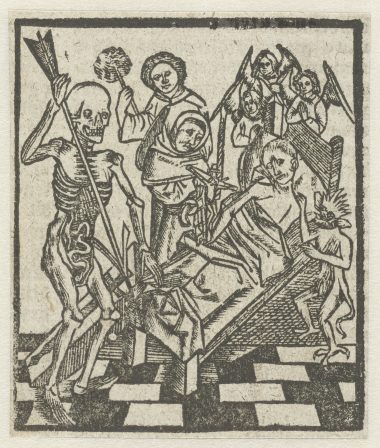The correct way of creating art
In this section, the characters discuss the correct technical process of creating a work of art.
Lack of visual clarity depicting the Holy Trinity as three equal figures
Regarding the Holy Trinity iconography of three equal figures seated with the same suit and age, with crowns on their heads and scepters in their hands, Pacheco considers an unclear iconography, since it might confuse “the ignorant”. He argues it needs a particular sign of attribute in which each person is known, as well as the distinction of each character and their places, in which the Holy Spirit has to be in the middle.
Archangel St. Michael with the weight scale
Concerning the representation of Archangel St. Michael, Pacheco is clear: is an inadequate manner to depict the St. without a weight scale. Such an element is considered essential to connect with the St.’s role, which is to help the common people to understand that it has the power to receive men’s souls and weigh their merits.
Matters uncertain in the sources, but whose depiction is judged probable by the painters
Molanus concludes that a certain pictorial tradition of an unestablished story does not mean this story has become certain, but that this way of depicting is most probable.
Paintings based on the apocryphal books, the Nativity of Mary and the Infancy of Christ
Molanus affirms that iconographies derived from apocryphal sources but that are approved by the commentators are allowed in art.
In painting St. Peter and St. Paul the painting tradition precedes written texts
Molanus discusses the conflicts between the written sources and the tradition in painting regarding the exterior features of St. Paul, in this case the pictorial tradition should prevail.
Painting of the crucifix described in the letter of the Suprema to the inquisition in Valencia
Letter of the Suprema to the Inquisitors of the town of Valencia describing some canvases that allegedly entered the kingdom and recommending that they be collected so that they do not continue to circulate.
How to represent St. Jerome (and how not to do it)
Dealing with the story of St. Jerome, Pacheco indicates two distinct ways of depicting this saint: one, in his penance in the desert, which is the most common, and the other one, in his cardinal’s costume.
Only theologians should Judge the religious aspects of art
Molanus argues that only theologians are capable of judging whether art is in accordance with the viewpoints of the Church.
Magistrates should take action against indecent art in public places
Molanus calls for the removal of lascivious art from public areas by worldly authorities.
Bacchus is a token of the unworthiness of drunkenness
Molanus condemns and ridicules the pagan gods and focusses on Bacchus.
Disbelief in the images of the saints, of the Virgin Mary and in relics
An old Christian (cristiano viejo) from Portugal does not believe in images of saints and the Virgin Mary, nor in relics
On the desirable education of a painter
The subject of the passage is the inadequate training of contemporary artists in comparison to antiquity, to which the participants attribute the errors in art. They cite ancient artists, such as Eupompus of Sicyon, as a positive reference.
The correct way of depicting “Christ’s dispute with the doctors in the temple”
Pacheco states in this passage how should be depicted the scene “Christ’s dispute with the doctors in the temple”. Also, he mentions the image made by Jeronimo Nadal as a good model to be followed.
Holy Scriptures are suitable decoration for churches
Molanus refers to Early-Christian sources and the Council of Nice for the decoration of churches and confirms the suitabilty of stories from the Holy Scriptures for this scope.
Joseph holding a green branch as a sign of his virginity
Molanus affirms that the green branch held by Joseph in paintings can only refer to his virginity.
Objects expressing sacrality
Molanus explains that certain objects, such as the cross, the aureole, and the palm, can be used in images to express sacrality.
The memory of bad people will vanish, despite ordering many artworks of themselves
Molanus argues that people will be recorded for their virtues, as the case of Apelles’ paintings of Alexander the Great demonstrates.
It is better not to befriend carvers and makers of images of saints
A certain Beltrán de la Borda was accused of despising images because he said that the friends of the carvers and makers of saints were “guitones”
The crucifixion
In the course of the passage, the participants discuss elements of the crucifixion.
How to represent St. John Baptist (and how not to do it)
What concerns the life of the saints, Pacheco started his analysis with the iconography of St. John Baptist. In his analysis, he pointed out four things: the first, his age and countenance; the second, his vestments; the third, his insignia; the last, the occupations and exercises in which he should be painted. Some inadequate elements of depicting the St. observed by Pacheco were: with fur; without a lamb; without a cross; eating, decomposed, drinking from a cliff stretched out of his breast.
Depiction of the martyrs by painters is often done according to convenience and should not be analysed in a too detailed manner
Molanus argues that the outer features of martyrs in paintings, such as their clothes and height, should not be taken too literally, since they are painted according to artistic convenience.
Devil in images of a dying people
Molanus affirms that one can paint devils and demons in images of dying people.
On how to depict St. Marc
Molanus discusses the exterior features of St. Mark, who would have been of the height and age of a mature man.





